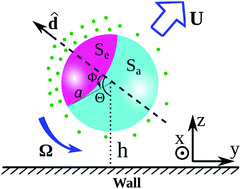Dynamics near planar walls for various model self-phoretic particles
Abstract
For chemically active particles suspended in a liquid solution and moving by self-phoresis, the dynamics near chemically inert, planar walls is studied theoretically by employing various choices for the activity function, i.e., the spatial distribution of the sites where various chemical reactions take place. We focus on the case of solutions composed of electrically neutral species. This analysis extends previous studies of the case that the chemical activity can be modeled effectively as the release of a “product” molecular species from parts of the surface of the particle by accounting for annihilation of the product molecules by chemical reactions, either on the rest of the surface of the particle or in the volume of the surrounding solution. We show that, for the models considered here, the emergence of “sliding” and “hovering” wall-bound states is a generic, robust feature. However, the details of these states, such as the range of parameters within which they occur, depend on the specific model for the activity function. Additionally, in certain cases there is a reversal of the direction of the motion compared to the one observed if the particle is far away from the wall. We have also studied the changes of the dynamics induced by a direct interaction between the particle and the wall by including a short-ranged repulsive component to the interaction in addition to the steric one (a procedure often employed in numerical simulations of active colloids). Upon increasing the strength of this additional component, while keeping its range fixed, significant qualitative changes occur in the phase portraits of the dynamics near the wall: for sufficiently strong short-ranged repulsion, the sliding steady states of the dynamics are transformed into hovering states. Furthermore, our studies provide evidence for an additional “oscillatory” wall-bound steady state of motion for chemically active particles due to a strong, short-ranged, and direct repulsion. This kind of particle translates along the wall at a distance from it which oscillates between a minimum and a maximum.



 Please wait while we load your content...
Please wait while we load your content...